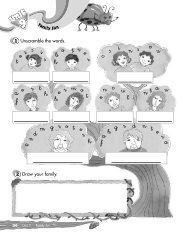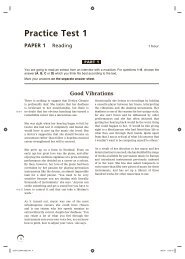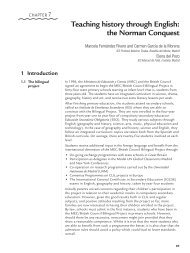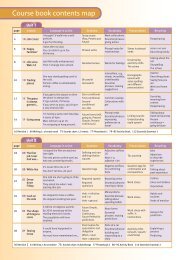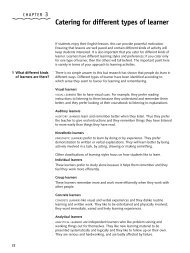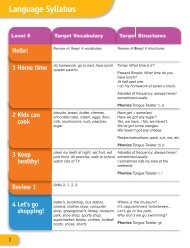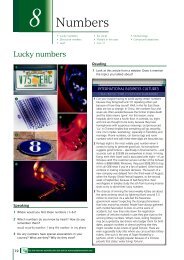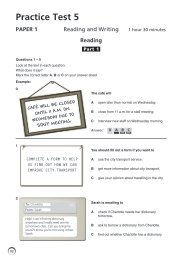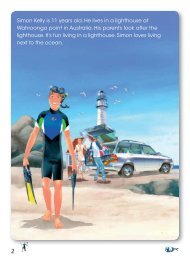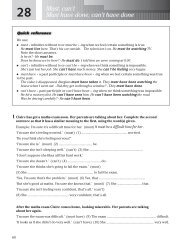Inthe kitchen
Inthe kitchen
Inthe kitchen
- No tags were found...
Create successful ePaper yourself
Turn your PDF publications into a flip-book with our unique Google optimized e-Paper software.
Grammar: Can/could: With ten beans, you could buya rabbit.Vocabulary: bar of chocolate, sweets, drink, ingredient,cacao bean, ceremony, god, tribute, slave, merchant,legend, money, hot, humid, wild, dry, exchange, pick.Materials: Small chocolates (1 per student).Warm-upYummy chocolate!Give each student a piece of chocolate to eat.On the board, write: CHOCOLATE.Divide the class into pairs. Students try to find achocolate product for each letter in the word chocolate.(Note: The letter can appear in the middle of the word.)coCoaHot chocolatecOokiesChocolate lollipopsbOx of chocolateschocolate miLkchocolate cAkewhiTe chocolatechocolate icE creamDeveloping readingStory: The history of chocolate, part 1 30Ask: Where does chocolate come from? Studentsspeculate and provide suggestions.Read the title of the story out loud.Explain that the story of chocolate starts in Yucatan,Mexico.Play Track 30. Students listen and follow along in theirbooks.Track 30The history of chocolate, part 1(See Student’s Book page 54.)Pause the CD after each paragraph and ask generalcomprehension questions: What is the most importantingredient in chocolate? Where did cacao beansoriginally grow? Who were the first people to eat cacaobeans? What did they use them for? Who introducedcacao beans to the Aztecs? What did the Aztecs usethem for? What did the Maya give the Aztecs as atribute?Divide the class into small groups.Students silently read the story. Tell them to underlinethe words in the story that they don’t understand.Working in their groups, students try to work out themeaning of the words. Provide assistance if necessary.In their groups, students read the story again and writea one or two sentence summary of the main idea ofeach paragraph.Elicit sentences and write them on the board.Optional activityClassify the words.On the board, write: Climate, Places, Cacao products.Divide the class into small teams.Students look through the story and find as manywords as possible for each heading.Teams read their words out loudReading comprehensionRead and underline the mistakes in thesentences.Read the sentences out loud.Students complete the activity individually.Write the correct sentences in your notebook.Students correct the sentences and write them in theirnotebooks. Ask volunteers to read the correctedsentences out loud.VocabularyWrite the following on the board: bar of chocolate,chocolate sweets, hot chocolate, cacao bean, merchant,rabbit, slave, Aztec god, religious ceremony, money.Students write the words/phrases in their notebooks inalphabetical order.Then they draw a small picture for each one.Finally, students write a sample sentence with each wordor phrase.Wrap-upSprinter’s raccoonPoint to the raccoon at the bottom of the page.Ask a student to read the text out loud.Ask: How much chocolate do you eat every week?Students calculate the total amount of chocolate theyeat in a year.Elicit results around the class.Activity BookPage 54, activities 1 and 2.KeyChocolate is very popular nowadays. The cacao bean is oneof the ingredients in modern chocolate bars. The cacao treegrows in wet, humid climates. The Mayans cultivated lots ofcacao trees. The Aztecs could not grow cacao trees in their dryclimate. The Aztecs used the cacao bean as money. With 10cacao beans, you could buy a rabbit. Nowadays you can buya bar of chocolate anywhere in the world.1. could; 2. couldn’t; 3. couldn’t; 4. could; 1. can; 2. can’t;3. can’t; 4. canUnit 5 In the <strong>kitchen</strong> T54




